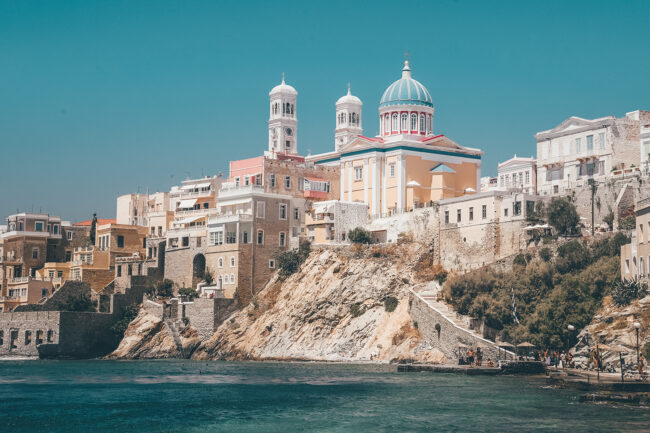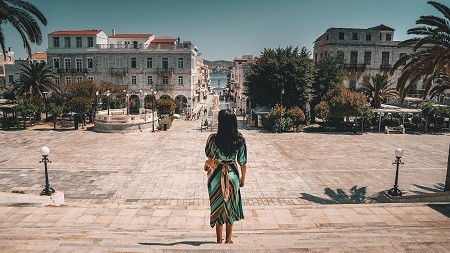The Diverse Architecture Of Syros

St. Nicholas, created by plans designed by Gerasimos Metaxas. J. Vaugarni, a French architect, also contributed with the design of the imposing edifice.
Ernst Ziller, Gerasimos Metaxas, Ippolit Monighetti, Pietro Sambo, J. Vaugarni, Ferdinand Béranger, and many Venetian minds have contributed to the rich architectural landscape of Syros, making the island a treasure trove of neoclassical, Byzantine, and Italianate designs. The combination of local craftsmanship and international influence has given Syros a unique architectural identity within the Cycladic Islands.
The architecture of Syros can be segmented into distinct regions that highlight various influences—from Venetian and neoclassical to traditional Cycladic styles. Below is an outline of the architecture by region on the island:

Dimarheio Ermoupoli / Town Hall, designed by Ernst Ziller.
Hermoupolis (Ermoupoli)
Hermoupolis, the capital of Syros and the administrative center of the Cyclades, is arguably the architectural heart of the island. Established during the 1820s Greek War of Independence, it was named after Hermes, the god of trade, reflecting the town’s role as a major shipping and commercial hub in the 19th century. The houses of Hermoupolis can be divided into three categories depending on their architectural features:
- Buildings of folk or insular type, as it had been known since the Ottoman era.
- Houses of neoclassical style, on which have been applied Greek and Renaissance design patterns (Romantic Classicism).
- Neoclassical buildings, with evident influences from Athenian Neoclassicism.
Neoclassical Grandeur: The neoclassical architecture of Hermoupolis sets it apart from other Cycladic islands, which typically feature whitewashed cube-shaped houses. Hermoupolis is dominated by stately mansions, elegant public buildings, and spacious squares that reflect the island’s wealth and significance during the industrial revolution.

Miaouli Square designed by Ernst Ziller.
Key Buildings
- Miaouli Square: The centerpiece of Hermoupolis, it is lined with neoclassical mansions and anchored by the grand Town Hall, designed by the famed architect Ernst Ziller.
- Apollo Theater: Pietro Sambo was the Italian architect who designed the Apollo Theater, one of Hermoupolis’ most notable cultural landmarks. The theater, built in 1864, is often referred to as a “mini La Scala” because its design is inspired by the famous opera house in Milan, Italy. It features a blend of neoclassical and Italian Renaissance styles, making it a symbol of the cultural sophistication of Hermoupolis in the 19th century.
- St. Nicholas Church: The foundations of this magnificent church were laid in 1849, created by plans designed by Gerasimos Metaxas. J. Vaugarni, as a French architect, also contributed with the design of the imposing edifice. It was completed in 1870, and it is one of the grandest churches in the Cyclades, with its impressive blue dome and marble façade. The domed basilica merges neoclassical elements with Byzantine architecture, making it a key religious and architectural monument on the island.
Industrial Architecture: In addition to its neoclassical elegance, Hermoupolis also showcases industrial buildings such as old factories and warehouses near the port, a testament to the island’s once-thriving shipping industry.

Apollo Theater designed by Italian architect Pietro Sambo.
Ano Syros
Although specific names may not be as well-documented, the medieval architecture of Ano Syros was heavily influenced by Venetian architects during the island’s time under Venetian rule (1207–1522).
The narrow, labyrinthine streets of Ano Syros are designed in the traditional Cycladic style, characterized by whitewashed homes with flat roofs, colorful doors, and shutters. However, the Venetian influence is clear in the defensive nature of the settlement, built in concentric circles to protect against pirate attacks.
Key Features:
- Catholic Cathedral of St. George: Perched at the top of the hill, this cathedral reflects the Catholic heritage of Ano Syros, which has been a Catholic enclave since Venetian rule.
- Fortified Village Layout: The houses in Ano Syros are built closely together, forming a natural fortress. The village is designed with narrow streets, archways, and covered passages to protect inhabitants from invaders.
- Cultural Character: Ano Syros retains a distinct medieval charm, with its cobbled streets and traditional Cycladic architecture blending seamlessly with Catholic churches and monasteries, showcasing a unique blend of Orthodox and Catholic traditions.

Syros aerial view.
Posidonia (Dellagracia)
Overview: Located on the southern part of the island, Posidonia—often referred to by its 19th-century name, Dellagracia—was once a summer retreat for Syros’ wealthy elite. The area is known for its grand villas and beautiful gardens, reflecting the prosperity of Syros in the 19th and early 20th centuries.
Ippolit Monighetti, a prominent Swiss-Russian architect, was involved in designing a number of private villas in the Posidonia area, which was known for its elite summer residences. His eclectic designs often incorporated neoclassical elements and reflected the tastes of the affluent families who built their homes in this area during the 19th century.
Neoclassical Villas: The architecture of Posidonia features elegant neoclassical mansions surrounded by lush gardens, a rare sight in the dry, rocky terrain typical of the Cyclades.
Key Villas and Other Features:
- Tsiropina Mansion: One of the most famous mansions in Posidonia, this villa represents the luxurious lifestyle of the island’s elite during its golden age, and it’s a typical example of the architectural style of the maisons en meulière, which are the French version of a broader category of revivals, of northern European mansions built in the late 19th to early 20th century.
- Elegant Mansions: These grand homes, often painted in pastel hues, feature arched windows, symmetrical façades, and elaborate balconies, blending neoclassical and Mediterranean styles.
- Italian Influence: The villas in Posidonia show a notable Italian architectural influence, with their graceful lines, terracotta roofs, and expansive verandas.
Other Villages and Coastal Areas
Traditional Cycladic Architecture: Beyond Hermoupolis and the elite villas of Posidonia, many of Syros’ smaller villages, such as Galissas and Kini, feature the more typical Cycladic architectural style—simple, cube-shaped houses with whitewashed walls and flat roofs. These villages are more rustic and are designed to blend harmoniously with the surrounding landscape.

Church of the Archangel Michael / San Michali.
Key Characteristics
- Whitewashed Houses: The simple yet beautiful homes found in these coastal villages are typically painted white to reflect the heat of the sun, with blue doors and windows adding a pop of color.
- Small Churches: Scattered throughout the island, particularly in the countryside, are small, domed churches that represent the island’s deep connection to the Greek Orthodox faith.
Syros stands out in the Cyclades for its architectural diversity, offering visitors a unique glimpse into both the island’s Venetian past and its 19th-century commercial prosperity. From the neoclassical splendor of Hermoupolis to the medieval charm of Ano Syros and the elegant villas of Posidonia, Syros is a living museum of architectural history. Whether walking through the grand squares of Hermoupolis or the winding alleys of Ano Syros, visitors are transported through time, witnessing the island’s layered history and the cultural influences that have shaped it.
For more information or to plan your visit to Syros, please visit syrosisland.gr.
About Syros
The municipality of Syros-Hermoupolis is dedicated to promoting the island’s rich cultural and culinary heritage. Focusing on sustainable tourism and the preservation of local traditions, Syros offers visitors an authentic and immersive experience of one of the Cyclades’ most beloved destinations.
